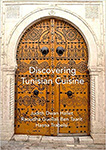Review — DISCOVERING TUNISIAN CUISINE by Judith Dwan Hallet (Tunisia) et al
 Discovering Tunisian Cuisine
Discovering Tunisian Cuisine
Judith Dwan Hallet (Tunisia 1964–66), Raoudha Guellali Ben Taarit, and Hasna Trabelsi; photographs by Judith Dwan Hallet and Stanley Ira Hallet (Tunisia 1964 – 1966)
Spirit of Place/Spirit of Design, Inc
December 2019
148 pages
$36.00 (hardcover)
Reviewed by Vana Prewitt (Liberia 1983–86; Peace Corps Response/S.t Lucia 2016
•
Discovering Tunisian Cuisine is as much a table-top photo book as cookbook, and sized appropriately so at 9″x12″. One can see the artist’s eye in the exquisite photos of food, scenery, and people. The authors admitted to struggling over the photos until they got it right. It is a nice balance of interesting history, beautiful photos, family recipes, and stories.
As a Returned Peace Corps Volunteer, I especially appreciated the insights to culture and history as it revolves around food.
For example, there are three theories about the origins of Brik, a traditional dish of North Africa that looks a whole lot like a hand-held Turkish spinach pie. The first theory is that briks were brought to the region by Berbers in the years before the birth of Jesus. The second theory is that the Ottomans brought it to Tunisia because the word “brik” sounds a lot like borek, and the root word, bur, means to twist and fold. Theory three suggests they were brought by the Jews in Djerba, Tunisia, who trace their roots back to the 6th century BCE. A brik is both a phyllo-type pastry and the fried hand pie, and one order’s a “lamb brik,” “spinach brik,” or “shrimp brik.”
As for the recipes in general, the ingredients are usually quite simple since these are foods a family eats daily. Mediterranean ingredients are featured, including lemons, legumes, peppers, tomatoes, mint, parsley, potatoes, garlic, onions, eggplant, asparagus, artichokes, and various greens. Many meat dishes are made with lamb, but there is a nice sampling of fish dishes that are simply baked, fried, or grilled.
There are a few recipes in the book that call for ingredients that may be hard to find in the U.S., such as preserved lemons, or oumelleh (pickled vegetables). Keep in mind that Tunisian ingredients are very similar to other countries of the Mediterranean for obvious reasons. A brik pastry in Tunisia is phyllo dough in Greece. The authors include recipes for these home staples in Tunisia kitchens.
Right now, it is cold, and I loved the Meatball Soup (hsou bel kaaber) made with ground round, which has an extra kick from the harissa.
I have made phyllo and Mediterranean pastries in the past and swore I would never do it again. That is a lot of work, but the recipes are here if you want to try.
I’m eager to try the Date Pastry (makroudh) but it says it takes practice. I can see from the recipe it would not be a normal pastry operation. and the dough could be very crumbly as it is made with semolina.
Vegetable dishes are eaten raw, fried or steamed, and there are also some interesting salads, including a Tunisian Salad (slata Tounsya) that includes hard-boiled eggs, tuna, and olives. I ate something much like this sitting on the border of Liberia and Cote Ivoire when I only had $1 U.S. in my pocket.
I enjoyed making and eating the Steamed Vegetable Salad (slata m’fawra) with its carrots, potatoes, peas, and scallions. These are very simple dishes.
The Tagines reminded me a lot of egg-based frittatas, but with added vegetables and cheese, again showing the cross-cultural influence in the region for thousands of years.
All in all, Discovering Tunisian Cuisine is a useful and beautiful orientation to the foods and the culture of Tunisia.
•
Reviewer Vana Prewitt, Ph.D. is a Returned Peace Corps Volunteer (x2) living in Sarasota, Florida. She served in Liberia 1983-86 and St. Lucia as a Response volunteer in 2016. Prewitt loves to cook and master new cuisines. She became a Rotarian in 2015 and began networking her peace journey with like-minded groups. She subsequently joined Partnering for Peace: Friend of Peace Corps and Rotary, and is now on the board.
Prewitt later became a Peace Ambassador for the Institute for Economics and Peace in Australia. A retired professor of organizational behavior, she first enjoyed careers in broadcast-journalism, and consulting as an organization development specialist. She has published mostly in academic journals with occasional contributions to magazines, newspapers, and radio. Until COVID, she was an avid traveler living in St. Lucia.
No comments yet.
Add your comment